While other plants hibernate, the Christmas rose blossoms. Here's what you need to know about planting and caring for Christmas roses.
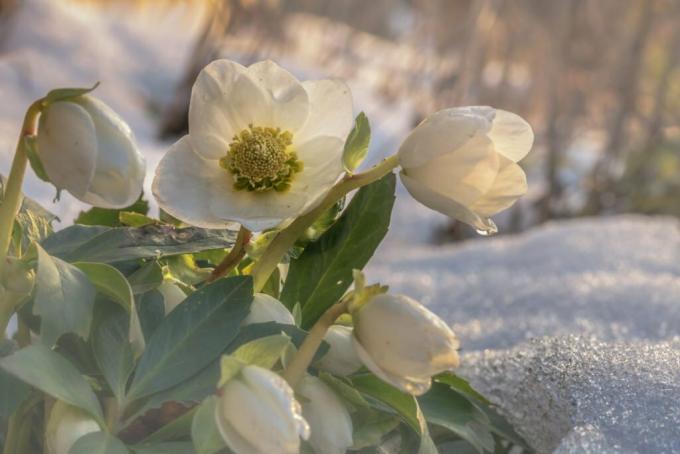
The Christmas Rose (Helleborus niger) is one of the most popular Christmas plants and enchants us with its beautiful flowers in the depths of winter. Black Hellebore, as it is also known, belongs to the buttercup family (Ranunculaceae). The perennial is best known for its early flowering period and is therefore ideal for decorating house entrances or Window boxes in the dreary winter months, because it opens its flowers when many other flowers are just going into hibernation are located. If you don't have a Christmas rose yet, you should think about getting this robust and easy-care ornamental perennial for your garden or balcony now.
contents
- Christmas roses: origin and meaning
- Do Christmas roses bloom in summer?
- Types and varieties of Christmas roses
- Buy Christmas roses
-
plant Christmas roses
- Plant Christmas roses: The perfect location
- Planting Christmas roses: instructions
- Plant Christmas roses in pots
- multiply Christmas roses
- care for Christmas roses
-
Common diseases and pests in Christmas roses
- black spot disease
- Rhizome and stem rot
- aphids and snails
- Are Christmas roses poisonous?
In this article we will answer some interesting questions - such as whether Christmas roses are poisonous and where they originally come from. We also introduce you to the most beautiful Christmas rose varieties and explain what you need to consider when planting, caring for and propagating black hellebore.
Christmas roses: origin and meaning
Perhaps you have already seen wild Christmas roses in nature. That would not be unusual for some HelleborusSpecies are also common in Europe. The ancestors of today's Christmas roses originally come from Southeast Asia, from where they are based on the Peak of the last Ice Age (about 20,000 years ago) west along the shores of the primeval Mediterranean Sea have spread. Due to the constant temperature changes during this time, they probably developed their ability to postpone and even interrupt the growth and flowering period.
The most familiar way Helleborus niger, is widespread in German-speaking countries as well as in Slovenia, Croatia and northern Italy, where it likes to inhabit bushy and sparse forests. It even occurs at altitudes of up to 1900 meters. Since there are hardly any specimens growing wild in many places, Christmas roses are particularly protected under the Federal Species Protection Ordinance. Fortunately, however, they have long been cultivated in monastery gardens and cottage gardens, so that today you can also buy cultivated varieties for your garden or balcony.

Helleborus niger is known by many different names. The literal translation of the botanical name is "Black Hellebore", because the crushed, black roots were used by pranksters as sneeze-powder. Since Christmas roses are poisonous, these fun actions could sometimes even end fatally - imitation is therefore strongly discouraged. The terms "Christmas Rose", "Christmas Rose" (in English "Christian Rose") or "Christkraut" are in turn on traced back to the tradition of cultivating them to flower on Christmas, around the day of Jesus' birth. In Austria, the terms "Schneerose" or "Schneebleamal" (i.e. "snow flower") are common, because in some areas they are already blooming when there is still snow.
Christmas roses have long symbolized the release from fear and even the ancient Greeks knew about the healing properties of the plant. However, the phytotherapeutic agent is currently only used in homeopathy. Rather, today the appearance of the Christmas rose is used in gardens and floristry. The white blossoms of the Christmas rose stand for hope and innocence. Also some poems are about the winter queen among the flowers.
Do Christmas roses bloom in summer?
The blossoms of Christmas roses open when many other plants are just hibernating, because Christmas roses need a cold stimulus for the blossoms to develop. This phenomenon of the plant world is called vernalization. Depending on the variety, the main flowering period is in the winter months between November and February. Some modern varieties, such as 'Double Fashion', bloom in mild years even into April.
We present other plants that bloom in November in our article Gardening in November in front.
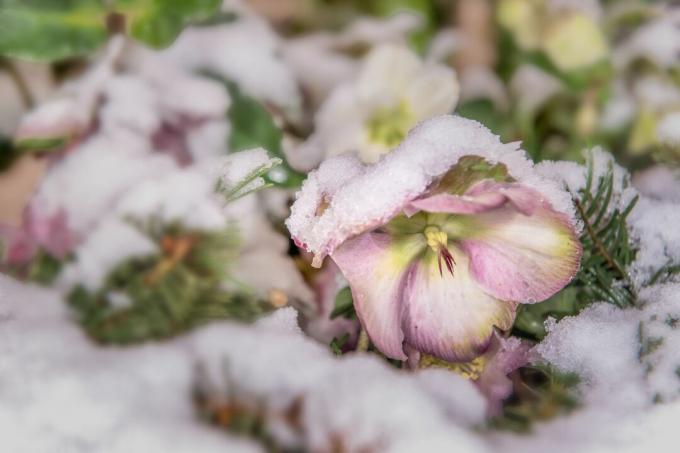
The white or reddish bracts of the Christmas rose change color as they bloom. They fade slightly and then usually change to greenish to reddish. The blossoms of the Christmas roses usually remain in this coloration for a while. After flowering, the foliage decorates the garden - so the Christmas rose serves us as an ideal one over the summer months ground cover and gap fillers.
Types and varieties of Christmas roses
In addition to the actual Christmas rose (Helleborus niger) there are about 20 more HelleborusSpecies, all of which are often mistakenly grouped under the name "Christmas rose" and are widespread in large parts of Europe and Asia. For example, the Oriental Hellebore (Hellebore orientalis), which is also called Lenten Rose or Spring Christmas Rose. Compared to Christmas roses, spring roses open their flowers a little later, namely in the period from January to March.
Basically, two groups of Helleborus distinguish: the trunk-forming (caulescent) and the non-stem-forming (acaulescent) species. As the name suggests, trunk-forming species are characterized by the fact that they form trunks above the ground. Furthermore, the rhizome is different than in non-stem-forming species, which means that that stem-forming species, unlike non-stem-forming ones, do not reproduce by division permit. While most Helleborusinclude species in the non-stem-forming group Helleborus niger an intermediate position. Although the Christmas rose does not form stems above ground, it has differences to the other species in the subgroup Helleborastrum into which all non-stem-forming species with the exception of the Tibetan Hellebore (Helleborus thibetanus) fall.
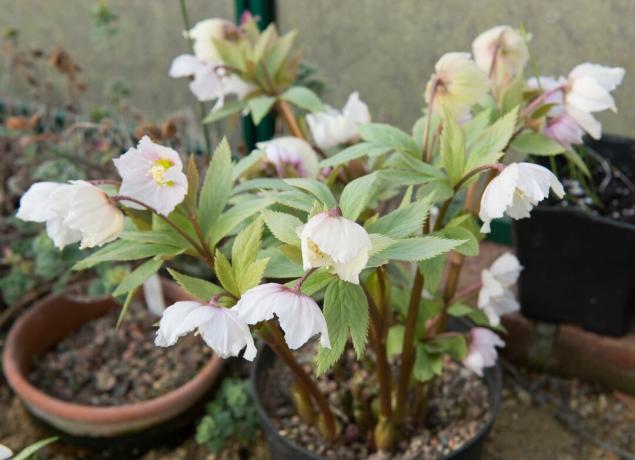
the kind Helleborus niger, which will be the focus of this article, is further subdivided into different varieties. To make it easier for you to choose from this wide range of Christmas roses, we would now like to introduce you to some particularly beautiful Christmas rose varieties.
Helleborus niger 'Christmas Carol': Pure white flowers with a yellowish-green center; main bloom from January to March; clump-forming, sprawling growth; grows about 10 to 20 cm high; wintergreen
Helleborus niger 'double fashion': White Helleborus niger 'Double Fashion'White double flowers; flowers from December; reaches heights of about 20 cm; suitable for sunny and semi-shady locations; very good winter hardiness
Helleborus niger 'HGC Jacob Royal': White flowers; blooms from November; strong and stable; medium growth; suitable for semi-shady and shady locations; very good winter hardiness
Helleborus niger 'HGC Joel': Plentiful, bright white flowers; flowers from December; compact, medium growth; suitable for semi-shady and shady locations
Helleborus niger‘Praecox’: White cupped flowers; flowering time from November to January; bushy growth; grows about 15 to 25 cm high; for semi-shady and shady locations; pretty tough
Helleborus niger 'HGC Jericho': Large-flowered variety; white flowers; flowers from December; dark green foliage; sprawling growth; grows up to 30 cm high; suitable for partially shaded locations
Helleborus niger 'White Christmas': Large, cup-shaped white flowers; grows about 20 to 30 cm high; blooms from December to February; prefers semi-shady locations; suitable for pot culture
Helleborus niger 'Maximus': Large-flowered variety; single, white flowers; flowering time from November to February; sprawling growth; grows about 35 cm high; for partially shaded places
Helleborus niger 'HGC Joshua': Early flowering variety (November to December); white, cupped flowers; sprawling growth; reaches growth heights of up to 30 cm
Helleborus niger ‘HGC Josef Lemper’: Early flowering variety (from December); white, cupped flowers; medium growth; grows about 25 to 30 cm high; for semi-shady to shady locations

It is best to plant Christmas roses in groups, then they come into their own. Planted slightly scattered, Christmas roses are also very suitable as underplanting for shrubs or trees. There are also wonderful combinations with other spring flowers such as tulips (Tulipa), crocus (Crocus)or snowdrop (glanthus). Appealing perennial beds can also be combined with cranesbill (geranium), lady's mantle (Alchemilla) or columbine (aquilegia) create.
Buy Christmas roses
Young Christmas rose plants can be found in many online shops. However, it is worth visiting a garden center or nursery to see for yourself. Depending on the season, Christmas roses are usually only available for sale in autumn. In addition to choosing a suitable variety, you should make sure that the Christmas rose you choose is healthy and strong, because despite their robustness, Christmas roses can be affected by fungal infestation. If there are black spots on the leaves of the plant or the flower stalks are bent at the base, it is better to stay away from this specimen. Small crawling creatures, such as aphids, like to eat Christmas roses. Therefore, when buying new plants, make sure that you only select healthy specimens that are free of pests.
What you at Buying Christmas roses should still be considered, we will explain to you again in detail in our special article.
plant Christmas roses
In the following, we will explain to you in which location Christmas roses feel most comfortable and what you should consider when planting so that your Christmas rose grows well.
Plant Christmas roses: The perfect location
If you have chosen a particularly beautiful Christmas rose for your garden, it is important to choose the right place for the planting. Basically, it is important that your Christmas rose has enough space in the garden to be able to develop undisturbed. Locations with nutrient-rich, well-drained humus soils that have a slightly alkaline pH of around 7 to 8.5 are ideal for Christmas roses. They feel most comfortable in the semi-shade under a tree. There the Christmas rose can enjoy the gentle rays of the winter sun during the cold winter months, but in summer it is protected from excessive heat.
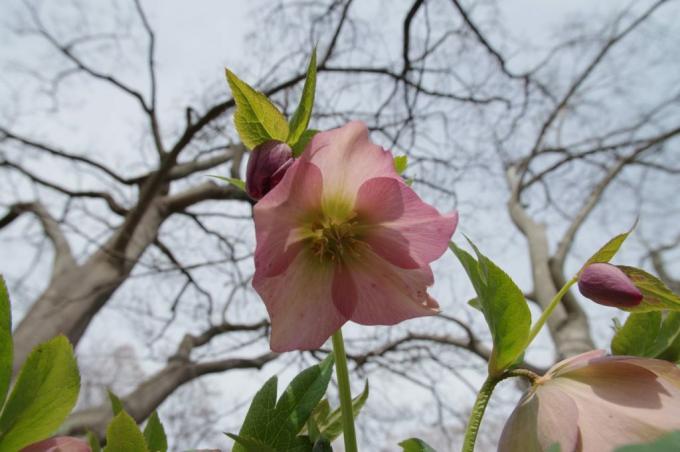
What you at the Site selection for Christmas roses You can find out anything else you should consider and the best place to place your Christmas rose in the pot in our special article.
Planting Christmas roses: instructions
Once you have chosen the right location, you should plant out your newly purchased Christmas rose as soon as possible. The best time to plant Christmas roses in the bed is in autumn (September to November). Alternatively, in rough locations, it can also be planted in late spring (April/May). Be sure to keep a sufficient distance (about 35 centimeters) to other plants so that there is no competition for light, water and nutrients. For higher-growing hybrids, you should keep a planting distance of about 50 centimeters.
Before planting, dip the root ball in a bucket of water to soak it up. In the meantime, loosen the soil at the desired location and dig out the planting hole, which is about twice the size of the root ball. To ensure good starting conditions, it is best to enrich the soil with a shovel compost and a handful horn shavings at. Now take the soaked Christmas rose out of the bucket and plant it up to the root neck. Press the soil lightly with your hands to seal any voids. Then you should water the freshly planted plant well so that the soil can settle. Finally, you can apply a mulch layer of coarse compost or leaves to ensure evenly moist conditions for the Christmas rose. Now you have to be patient, because it can sometimes take a year or two for young specimens to flower for the first time.
You should only replant Christmas roses if absolutely necessary, because they usually do not tolerate a change of location very well. In the worst case, it can even lead to the death of the plant. If it is still unavoidable, the best time to do so is in autumn (September) or spring (March/April). The more root mass is preserved, the greater the chance of a successful resettlement. Also make sure that the planting depth at the new location is maintained as much as possible.
Tip: To avoid skin irritation, be sure to wear gloves when planting Christmas roses.
Plant Christmas roses in pots
So your Christmas rose in a pot thrives well, there are a few aspects to consider when planting. Christmas roses are deep-rooted, which is why you should choose a sufficiently large planter for your darling. First of all, a drainage layer is placed in the pot so that excess irrigation water can drain off. In this way, waterlogging can be avoided.
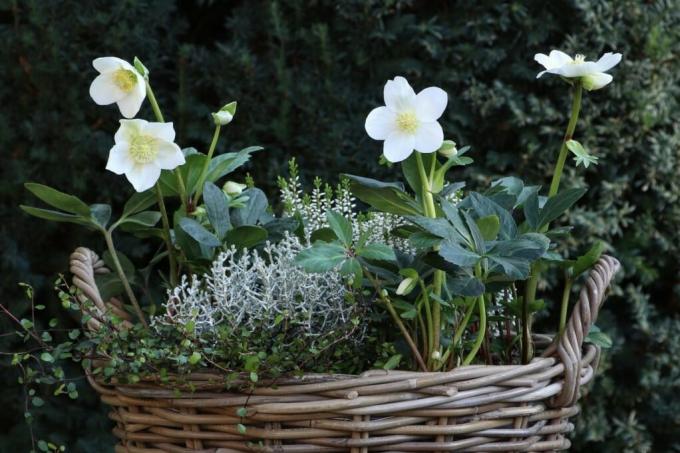
A high-quality potting soil such as our peat-free one is suitable as a substrate Plantura organic potting soil. It provides your Christmas rose with nutrients and can be made a little more permeable by mixing it with sand. Once the Christmas rose has been planted, a partially shaded spot on the balcony or terrace is a wonderful location. From then on, you should take good care of your darling, because Christmas roses in pots make slightly higher demands on care than outdoors. In addition to regular watering and fertilizing, sufficient frost protection must be provided so that the roots in the pot do not freeze through in winter. Which varieties are suitable for pot culture, how exactly you should proceed when planting and what is involved in the Caring for Christmas roses in pots we explain to you here.
multiply Christmas roses
If you can't get enough of Christmas roses, you should consider propagating particularly beautiful specimens yourself. The simplest method is probably root division after flowering in spring. To do this, first tie the leaves together loosely with raffia and then push a pitchfork through the center of the root ball. A second pitchfork is then placed just below the first. Now gently move both pitchforks back and forth to divide the rhizome. Be sure to dig the Christmas rose deep enough to preserve as much root mass as possible. Then plant the newly acquired plant directly in its new destination and water it well. By the next season, the Christmas rose should be blooming again.
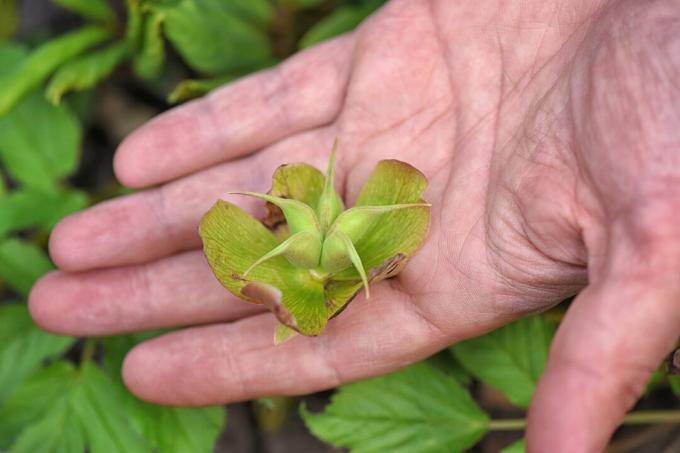
Alternatively, you can also propagate your Christmas roses from seeds. A varietal propagation is not possible. In addition, this method of propagation is very time-consuming and labor-intensive. If you still want to make the effort, remove the seeds from the ripe fruits in early summer.
Fill a freezer bag with damp sand and then refrigerate the seeds for about four to six weeks before planting. This so-called stratification of the seeds is necessary because Christmas roses are cold germinator acts. You can achieve a similar effect if you place the seed pot on the balcony over the winter. Alternatively, you can simply fade the Christmas roses in the bed and let the follicles burst. Next spring you can look forward to the first seedlings. However, the first flowers usually take about three to four years to appear.
care for Christmas roses
When the Christmas rose has grown well, it makes little demands on its care compared to other ornamental perennials. Sufficient watering is important during the flowering period from November to February. But even outside of the flowering period, the root ball should of course not dry out completely. Therefore, keep an eye on your Christmas rose over the summer months so that you can water it if necessary. A mulch layer made of compost, leaves or grass clippings not only keeps the soil moist, but also provides your Christmas rose with nutrients. However, regular pruning is not necessary for Christmas roses. In early summer (May), simply cut off the withered flower stalks so that the Christmas rose does not invest its energy in forming seed heads. The old foliage is only removed when it is completely drawn in.

Everything about the topic "care for Christmas rosesYou can also read about it in our special article.
Common diseases and pests in Christmas roses
Unfortunately, even the robust Christmas rose is not immune to infection with plant diseases and infestation with pests. We have therefore compiled an overview of the most important diseases and pests on Christmas roses below:
black spot disease
Black spots often form on the leaves of Christmas roses over the course of the year. These are caused by a fungus long known by the name Coniothyrium hellbori was known. However, the exact origin of the pathogen is still the subject of research. According to recent findings, he is therefore more of the genus Phoma or Microsphaeropsis assigned. You can recognize the so-called black spot disease by the irregular, round black spots that appear particularly on the edges of the leaves. A particularly severe infestation can lead to the death of the leaves and should therefore be treated as soon as possible. To do this, remove the old diseased foliage. To prevent the leaf spot disease from spreading further, do not dispose of the planting material in the compost, but in the residual waste. Too low a pH in the soil, an oversupply of nitrogen and persistently wet leaves can promote fungal infection. Therefore, always ensure optimal site conditions so that your Christmas rose does not lack anything. If the worst comes to the worst, fungicides are also available, but they should be used as soon as the first symptoms appear in order to achieve an ideal effect.
Rhizome and stem rot
If in spring the shoots of your Christmas rose snap off at the base and brown at the base for no apparent reason have black rotten spots, this is probably an infestation with the so-called rhizome or stem rot. For this purpose, various mushrooms, such as Pythium, Phytophtora or Rhizoctonia,to be responsible. Unfortunately, combating these pathogens is almost impossible. Therefore, prevent the disease by planting the plant in a well-drained soil, because prolonged waterlogging can favor the appearance of these fungi.
aphids and snails
In addition to fungal diseases, pests can also attack your Christmas rose. Aphids literally love to eat the leaves of the Christmas rose. However, they pose no real threat to the plant. If you still want to do something about it, you can treat the affected leaves with a nettle broth you have prepared yourself or a biological preparation from a garden store spray.
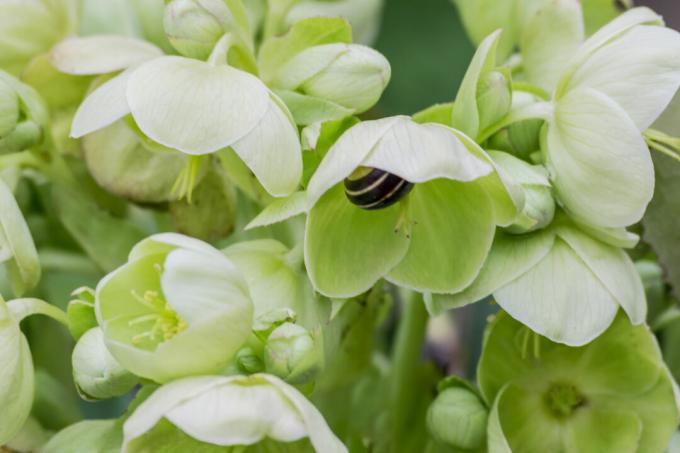
Snails, on the other hand, like to nibble on young cotyledons and leaves, so that there is hardly anything left of the plant. For the sake of the environment, you should use biological means to combat snails.
Here are a few ways you can Fight snails effectively be able.
Are Christmas roses poisonous?
Yes, all parts of the Christmas rose plant are poisonous and therefore unfit for human consumption. Responsible for this are various toxic ingredients such as the protoanemonin found in buttercup plants. in the genus Helleborus In addition, the heart toxin Helleborin and the steroid saponin Helleborin, which has a strong effect on the heart, are added. The roots are particularly poisonous, so that poisoning by snow roses is rarely observed. When gardening, however, escaping plant juices can lead to skin irritation. Therefore, always wear gloves when handling Christmas roses and do not touch your face while gardening. Among pets, puppies and young cats are particularly at risk, as they may ingest the poisonous seeds and roots out of curiosity.
In our special article on the subject, we explain how you should react in the event of poisoning and how you can ensure that it doesn't get that far in the first place Poisonous Christmas roses.
